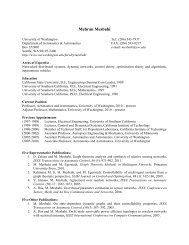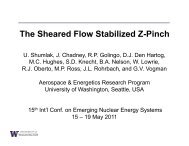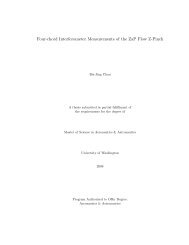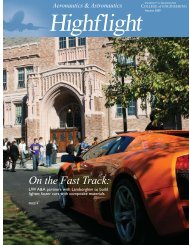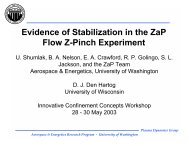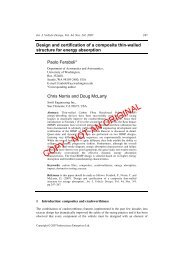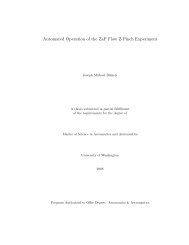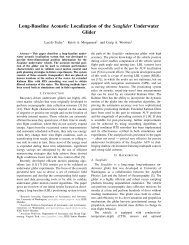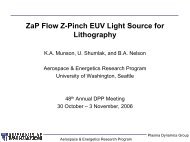Distributed Reactive Collision Avoidance - University of Washington
Distributed Reactive Collision Avoidance - University of Washington
Distributed Reactive Collision Avoidance - University of Washington
Create successful ePaper yourself
Turn your PDF publications into a flip-book with our unique Google optimized e-Paper software.
22<br />
in D.<br />
If D is empty, then each vehicle uses ξ i (j) to determine when to maneuver, where j is<br />
the nearest vehicle. If vehicle i is less maneuverable than vehicle j, then ξ i (j) will turn<br />
false before ξ j (i) does. In this case, vehicle i becomes an element <strong>of</strong> D, making D = {i},<br />
but vehicle i does not perform a deconfliction maneuver, since vehicle j will be able to<br />
safely deconflict even if the vehicles move closer together. Now that D is nonempty, the<br />
system then follows the previous directions. Once ξ i (D) becomes true again, vehicle i is<br />
removed from D and solely follows its desired control.<br />
The deconfliction maneuvers used here are in fact simple optimization schemes with<br />
the goal <strong>of</strong> finding the smallest velocity change necessary to attain a conflict-free state.<br />
In this sense, the maneuvers are most similar to [8, 24] (in fact, because these authors’<br />
optimization schemes use the same definition <strong>of</strong> conflict, they could also be used as deconfliction<br />
maneuvers here). However, these two optimization schemes are centralized and<br />
computationally expensive. More importantly, they do not give a bound on how far apart<br />
the vehicles must be for a feasible solution to exist. This bound is <strong>of</strong> the utmost importance<br />
for designing a safe system.<br />
This algorithm is greedy in the sense that each vehicle minimizes its own cost function<br />
(‖∆v i ‖), meaning that the solution will not be a global optimum for some overarching cost<br />
function <strong>of</strong> the group. However, given the nonconvexity <strong>of</strong> the problem, finding any global<br />
optimum is nontrivial. For instance [8] used a semidefinite relaxation, but still required a<br />
random initial guess, and hence could not guarantee a global optimum either. Additionally,<br />
the actual cost function for the system is unknown in general, since any desired controller<br />
can have its own unique cost function associated with it, depending on the task. Therefore,<br />
instead <strong>of</strong> attempting to minimize an arbitrary cost function, a suboptimal solution will be<br />
allowed, with the focus instead on feasibility and low computation load.<br />
The only information the DRCA algorithm needs on a continuous basis is the position<br />
and velocity <strong>of</strong> each vehicle in D, which can either come from broadcast communication<br />
(e.g. a transponder) or sensing (e.g. radar). If the system is heterogeneous, then the vehicles



